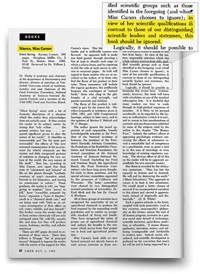Advertisement
Grab your lab coat. Let's get started
Welcome!
Welcome!
Create an account below to get 6 C&EN articles per month, receive newsletters and more - all free.
It seems this is your first time logging in online. Please enter the following information to continue.
As an ACS member you automatically get access to this site. All we need is few more details to create your reading experience.
Not you? Sign in with a different account.
Not you? Sign in with a different account.
ERROR 1
ERROR 1
ERROR 2
ERROR 2
ERROR 2
ERROR 2
ERROR 2
Password and Confirm password must match.
If you have an ACS member number, please enter it here so we can link this account to your membership. (optional)
ERROR 2
ACS values your privacy. By submitting your information, you are gaining access to C&EN and subscribing to our weekly newsletter. We use the information you provide to make your reading experience better, and we will never sell your data to third party members.
Environment
Pernicious POPs
April 20, 2015
| A version of this story appeared in
Volume 93, Issue 16
Learning that persistent organic pollutants (POPs) are still being relentlessly pursued by persistent old chemists (POCs) reminded me of my own career in environmental sciences at Dow Chemical beginning in the 1960s (C&EN, March 2, page 10).
While contemplating distribution, fate, and toxicity of chemicals, I predicted that the level of detection of any POP must fall to such a low level that a POC must atomize the last remaining molecule to prove it is no longer persistent. Having been a long-time observer of Michigan and the Great Lakes region, I firmly believe that pertinacious perseverance in purposeful pursuit of perpetual persistence is pragmatically praiseworthy.
I would posit, however, that most organic chemicals should be judged innocuous until proven noxious. Their natures of being are not to be inherently stable or persistent (resistant to environmental degradation), despite efforts to structurally engineer such qualities in or out by crafty elemental substitutions. The “persistences” of synthetic POPs were subject to scientific scrutiny well before clarion calls for global action and regulatory decree.
More than 5,200 scholarly papers on POPs have been authored by hundreds of POCs. Yet implications of persistence of synthetic chemicals versus degradability of natural chemicals still persist in the literature. Persistent traces of pesticides, drugs, cosmetics, and so on are still perceived as failures of natural attenuation processes or as limitations of applied engineered treatments. Such is the nature of future environmental research. It is impossible to reduce all POPs everywhere at all times without leaving some problematic POP for the dedicated POC to ponder and pontificate over.
The challenge of modern chemistry lies in balancing persistence (strength against change) and lack of persistence (weakness against change). I suggest “pusillanimity” in a metaphysical, nontheological sense, to be the antithesis of persistence, to allow for “pusillanimous organic pollutants” that are amenable to change and nonpersistence.
Pusillanimity
Environs in close proximity
Their true natures have affinity.
To be, or not, to coexist.
Separate out the chaff from grist.
Leave ashes, dust to infinity.
The destiny of our sublimity
Bears judgment of implied divinity.
It seems, while many things persist,
More other things do not resist.
The cause? ’Tis pusillanimity.
Stacy L. Daniels
Midland, Mich.




Join the conversation
Contact the reporter
Submit a Letter to the Editor for publication
Engage with us on Twitter